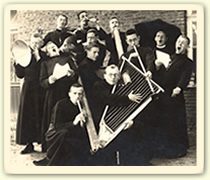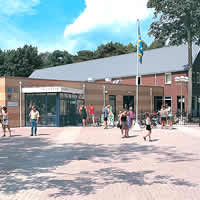 Well knownDutch vacation facility has Vincentian roots. Over 100 years ago, in 1904, the French “Lazarist” order acquired an 11 hectare plot behind Beringe. In 1905, building work began for a hall where meals could be taken at lunch time. This is the characteristic “Patershof” monastic building near the entrance to the camp site. In 1908, the area was named “Emmaüs”, and until 1965 remained the weekly leisure venue for the priests and novices.
Well knownDutch vacation facility has Vincentian roots. Over 100 years ago, in 1904, the French “Lazarist” order acquired an 11 hectare plot behind Beringe. In 1905, building work began for a hall where meals could be taken at lunch time. This is the characteristic “Patershof” monastic building near the entrance to the camp site. In 1908, the area was named “Emmaüs”, and until 1965 remained the weekly leisure venue for the priests and novices.
Thanks to the enterprising spirit and imagination of these student clergy, the complex emulated the notion of an “earthly paradise”. Various buildings, summer houses and sports fields were erected over time. Two ruins near the playground and the midget golf course are reminiscent of that period.
The fishing lake across the road was excavated completely by hand also at that time and then served as the first “swimming-pool” in the municipality of Helden!
Since 1970 the Beringerzand camp site has grown into a small village (20 ha, with about 250 permanent and 350 touring spaces), with free “residents” and all modern conveniences.
Historic midget golf course “Emmaas”
The rich history of the Beringerzand camp site can be seen and read up on lovely information boards in this midget golf course. This midget golf course is the Lazarists’ former garden of the Virgin Mary. The route in the midget golf course takes you back to these bygone times. You will even be walking around the ruin of “the Virgin’s grotto” or “Lourdes grotto”…
Tuinen en tuinieren
GARDENS AND GARDENING (English)
Gardening was one of the activities and hobby’s of the Lazarists. Within Emmaüs various different gardens were designed. A lot of time and attention was paid to it and therefore caused that the gardens always looked perfectly. There were ornamental gardens with small sofas and footpaths, but also vegetable gardens and lawns.
Green Fingers and A Creative Heart
It is hard to discover the exact locations of these various gardens. Only the location of the Mariatuin and the Toneeltuin are known, thanks to the Mariagrot and through the map which clearly shows the amphitheatre.
ENGLISH GARDEN
When you walked through the entrance gate the English garden was located at the right. In the English garden there was a small garden house with reed roof in which, in an English way, a real “Tea-time” could be organized.
TONEELTUIN (THEATRICAL GARDEN)
Bemfica (see theme “houses”) was part of the Toneeltuin. At Bemfica, you could climb the stairs to the stage. Between the stage and the seats the Lazarists had developed a beautiful garden. This garden didn’t only embellish the theatre, it also caused a buffer between public and players. In the middle of this garden there was a pond. This pond wasn’t just decoration, but was especially meant as sound support. Water “carries” sound well. Microphones didn’t exist yet in those days…..
HARTJESTUIN (HEART GARDEN)
De Hartjestuin was also called the “Javanese Garden”. The Lazarists tried to copy a Javanese landscape here, complete with Javanese cabin. The Lazarists called this Javanese Cabin “Het Kotjeâ€â€¦.
Before the Amphitheatre and Toneeltuin were completed, plays were performed in the Hartjestuin. On the photo you will observe attempts to build a Javanese cabin in the Hartjestuin! This Javanese cabin can be seen on the photo, behind the décor, during a play.
MARIATUIN (MARY GARDEN)
Around the Mariagrot (Mary cave) a beautiful ornamental garden was developed with the appropriate name “Mariatuin”. While you read this you are situated in the middle of this Mariatuin. For good reason, the Mariagrot is part of the route in the midget golf game. In the Mariatuin, the Lazarists settled down and prayed to Mary.
Additional information about this present-day, Dutch vacation facility near the German border can be found at the following Web site:
Tags: CM, Congregation of the Mission

the website address is: http://www.beringerzand.nl/en/camping_index.htm
Thanks, Toma. The lack of the link was an oversight that needing remdying.